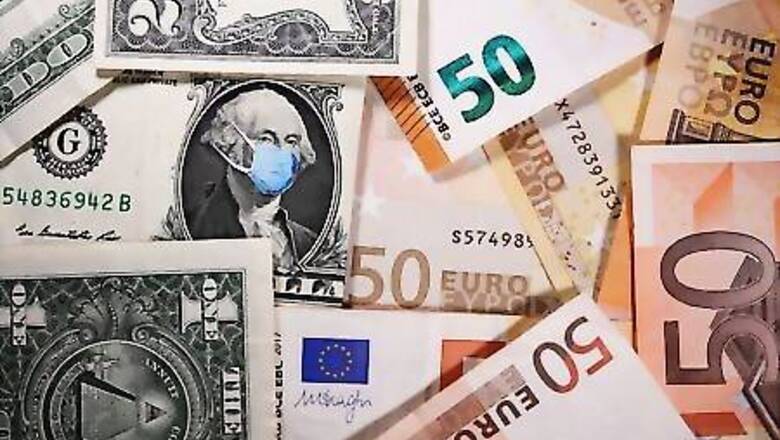
views
BENGALURU The dollar’s supremacy of well over two years has turned sharply and the current downward trend will continue into next year on expectations the U.S. economic recovery is flagging, especially compared to Europe, buttressing the euro, a Reuters poll showed.
A surge in coronavirus cases across several U.S. states and some data pointing to an economic recovery losing steam pushed the dollar index down 4.1% in July, its biggest monthly percentage fall in a decade.
That was reflected in the latest positioning data, which showed speculators increased their bets against the dollar to the highest in nine years and at the same time raised their bets in favor of the euro to the highest on record.
A deteriorating economic outlook has driven down U.S. Treasury yields across the curve to record or near-record lows, and gold jumped to a record high on Wednesday, pushing further past $2,000 in the face of a weak dollar, a common hedge during times of economic uncertainty.
“There is no doubt the dollar has made a cyclical turn now … the dollar is extremely expensive and that’s not sustainable given the current monetary policy stance, nor is it sustainable given the outlook for growth over the next few years,” said Kit Juckes, head of FX strategy at Societe Generale.
“The dollar’s weakness is reflected in a stronger euro, also driven by a large position shift that sees net longs as big as they were just before EUR/USD peaked in 2018 … Seasonal patterns don’t point to EUR/USD weakness in August, and the longer-term euro trend is upwards.”
The July 31-Aug. 5 poll of more than 60 currency strategists showed the dollar was expected to continue to underperform against most major currencies over the coming 12 months, with a good chance of that weakness extending beyond a year.
Indeed, more than half the strategists, or 33 of 62, in response to an additional question said the dollar’s weakening trend would continue for at least another six months, including 24 respondents who expect it to run for more than a year.
About a quarter, or 15 analysts, said it would be less than six months. While 11 said it would be less than three months, just three respondents said it was already over.
“Following some hesitancy in June and the first half of July, the negative forces acting on the USD have returned to the fore. The in principle approval by European Union leaders to the proposed recovery fund and the associated EUR/USD response has been the catalyst for a generalised move lower in the USD,” said Gavin Friend, senior FX strategist at NAB.
“This has some way to play out.”
The euro traded below $1.10 as recently as May. But the single currency soared around 5% in July, marking its best monthly performance in a decade, with much of those gains coming after EU leaders agreed a 750 billion euro economic recovery fund, where it will borrow jointly for the first time – a major boost to regional cooperation.
While the euro was not forecast to carry the same momentum, it was still expected to end the year on a high.
The single currency was expected to trade at about $1.18 in a year’s time, around where it was last trading on Wednesday. That consensus view was the highest in a year and the range of forecasts pointed to higher highs and higher lows.
Reuters poll: EUR/USD outlook https://fingfx.thomsonreuters.com/gfx/polling/xklpydlngvg/EUR%20graphic.PNG
In the derivatives markets, the one-year euro forward was last trading at $1.19, suggesting more upside to the currency’s strength.
“The euro has been significantly weaker post-financial crisis because global investors are much less confident of the financial architecture – in particular the role of fiscal policy in the European economy. Though they’re less pessimistic about that today than they were a month ago,” added SG’s Juckes.
Twenty-eight of 55 analysts who answered a separate question said major developed market currencies, most of which rose against the dollar in July, would perform better against the dollar over the next six months.
Twelve said emerging market currencies, six said commodity-linked currencies, while the remaining nine respondents said all of those currencies.
(For other stories from the August Reuters foreign exchange poll:)
Disclaimer: This post has been auto-published from an agency feed without any modifications to the text and has not been reviewed by an editor

















Comments
0 comment